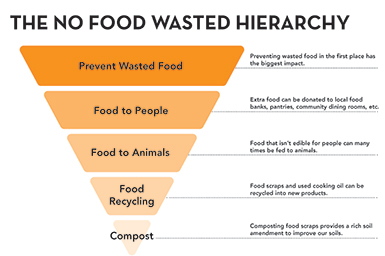Food Recovery
Castro Valley Sanitary District (CVSan) promotes the 4Rs in everything we do – Reduce, Reuse, Recycle and Rot. As we get closer to reaching our goal of zero waste by the year 2029, making the first two Rs, Reduce and Reuse, a higher priority will be essential. Recycle and Rot will continue to be important, but by focusing on the source of waste before it happens, we can prevent much of it.
For food waste prevention, it is best to reduce the amount of food you make or buy, but inevitably, there will be some surplus or “wasted” food for businesses, schools, institutions, and residents.
What should you do with surplus food? It depends on how much you have, but in general, the U.S. Environmental Protection Agency (EPA) has found that feeding people first with surplus food is best for the environment. The EPA has developed a Food Recovery Hierarchy that shows how surplus food, which is still safe and edible should be dealt with. CVSan has developed a similar hierarchy offering ways to reduce wasted food in the community.
The environmental and social impacts of food and food waste are significant. Growing and producing our food requires vast amounts of resources such as water, energy, and fuel for transportation. Efficient use of these resources reduces waste at its source.
If we have leftover food that is still good, we should feed hungry people. We waste approximately 40 percent of all of our food, while 90 percent of what’s good and unwanted gets thrown away in the garbage or compost.* In addition to environmental impacts, wasting food is bad for our community because we still have 50 million food-insecure people in the United States.* One in six adults and one in three children are food-insecure in Alameda County, which means they face the threat of hunger on an ongoing basis.**
*Dana Gunders-Wasted: How America is Losing Up to 40 Percent of its Food From Farm to Fork to Landfill.
**Alameda County Community Food Bank 2013 Annual Report
SB 1383 – Organics and Recycling Law
California has passed Senate Bill (SB) 1383, which aims to reduce food and other organic material we send to the landfill. Beginning in January 2022, SB 1383 regulations will be implemented in Alameda County under the Organics Reduction & Recycling Ordinance (ORRO).
Certain food service businesses, also known as commercial edible food generators, must comply with SB 1383’s edible food recovery requirements. Visit cvsan.org/SB1383 for more information on SB 1383 and a list of requirements for businesses.
Local Options To Save Food And Donate It To Those In Need:
What are your options for saving food in Castro Valley and finding people in need that want it? Check out StopWaste’s list of food recovery organizations and services that accept donations of edible food. This list includes helpful resources located either in or near CVSan territory.

